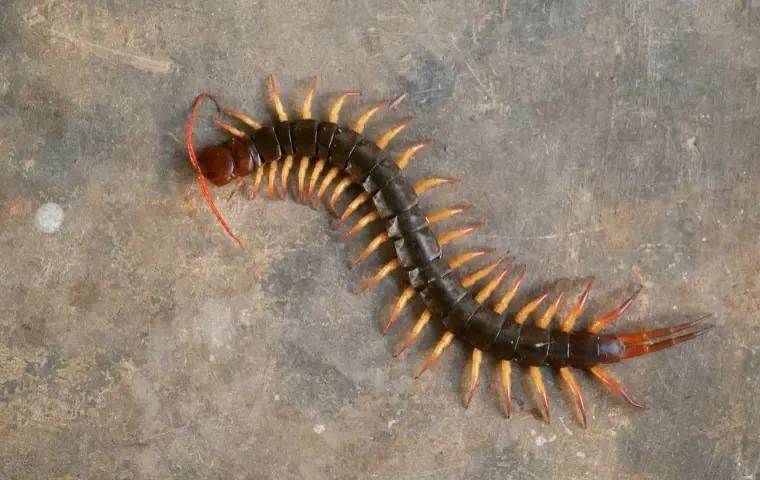What Do Centipedes Eat?

If you’ve been spotting a lot of centipedes in your home, this could be a sign that their preferred prey, such as insects and spiders, has found a welcoming environment in your living space.
To reduce the likelihood of a centipede infestation, it's essential to do proper pest control and manage the populations of potential prey insects within the house.
In this article, you’ll understand what centipedes eat, what type of environment they like, and how you can prevent your home from turning into a house centipedes eat.
Key Takeaways
- Centipedes are primarily carnivorous and consume a variety of insects and small animals.
- They thrive in dark, moist environments such as basements, soil, leaf piles, rocks, and compost areas.
- Implement proper pest control to manage populations of potential prey insects.
- Reduce moisture in the home and eliminate dark hiding spots to discourage centipede infestations.
Centipede Diet and Prey
Centipedes are arthropods with elongated bodies and an impressive number of pairs of legs. They’re often mistaken for millipedes due to their similar body shapes and long legs.
However, centipedes have one pair of legs per body segment and are primarily carnivorous, while millipedes have two pairs of legs per body segment and are generally herbivorous.
Centipedes eat various insects and other small animals and invertebrates. The scutigera coleoptrata (commonly known as the house centipede), for example, can feast on crickets, cockroaches, silverfish, moths, and earthworms.
Habitat and Hunting Behavior
Centipedes showcase a variety of hunting behaviors that are tightly linked to their environmental preferences. These critters have specific habitat needs, thriving in conditions that support their nocturnal lifestyles.
Where Do Centipedes Live?
Centipedes are attracted to crevices and dark places. They often seek out habitats that provide adequate moisture, such as soil, leaf piles, rocks, and compost areas.
The house centipede adapts well to indoor spaces like basements where humidity is higher, while wild centipedes tend to favor outdoor settings, including lush tropical regions, where they can burrow to maintain their moisture levels.
Are Centipedes Poisonous?
Centipedes primarily target insects, spiders, and other small arthropods. Larger species have even been observed taking down bigger prey. While their venom can kill small insects, it is not a threat to humans.
- Predator: Centipedes are agile hunters, relying on their speed and venom to overpower their victims.
- Bite: Equipped with forcipules, modified front legs evolved into venomous fangs, centipedes use these to deliver a venomous bite. The forcipule's puncture allows them to inject venom directly into the prey.
Centipedes at a Glance
Diet & Prey | Primarily carnivorous; feeds on insects, small animals, and invertebrates like crickets, cockroaches, silverfish, moths, and earthworms. |
Habitat | Prefers dark, moist environments such as soil, leaf piles, rocks, compost areas, and humid indoor spaces like basements. |
Hunting Behavior | Nocturnal predators; use speed and venomous front fangs (forcipules) to immobilize or kill prey before consumption. |
Sensory Mechanisms | Utilize antennae with sensitive receptors for navigation and detecting vibrations/chemical signals; legs for swift movement; mandibles for consuming prey; claws in some species for gripping and dissecting food. |
Centipedes and Human Interaction
For many homeowners, centipedes can be a nuisance. When centipedes venture into your home, they're usually seeking shelter or hunting for smaller household pests.
Benefits of Centipedes
- Feeds on smaller pests: Centipedes serve as natural pest control, targeting spiders, bed bugs, roaches, and other household pests.
- Reduces the use of chemicals for pest control: Their predacious lifestyle minimizes the need for chemical repellents, contributing to a balanced home ecosystem.
Risks Associated with Centipedes
- Can cause an allergic reaction: While centipede bites may lead to swelling and pain, serious allergic reactions are rare.
- Potential for a painful bite: Centipede bites are typically not serious and occur rarely, usually subsiding quickly.
Centipede Control in South Florida
If the presence of centipedes in your home becomes a significant concern, pest control methods ranging from reducing moisture in the home to setting up traps can help in getting rid of centipedes. However, as with any pest problem, calling a pest professional is the best way to ensure you get rid of centipedes for good.
Frequently Asked Questions
Centipedes are carnivorous creatures, so their diet mainly consists of other small insects. They're known for hunting their prey at night and are a natural form of pest control. Here are some of the common queries about what centipedes eat.
What's on the menu for centipedes when they're roaming around our homes?
When centipedes are in the house, they usually feed on spiders, bedbugs, termites, cockroaches, silverfish, and other household pests.
Can centipedes survive on the same snacks we humans enjoy?
Centipedes don't share our taste for processed snacks. They strictly prey on living creatures that are small enough for them to capture and eat.
When I spot a centipede chilling in my garden, what's it likely munching on?
Garden centipedes feast on soil-dwelling insects, larvae, and soft-bodied critters, such as worms and slugs, helping control pest populations in your garden.
Are ants considered a centipede delicacy, or do they prefer other insects?
Centipedes do eat ants, although they are not their primary choice. They generally go for softer-bodied insects that are easier to digest.
Got a pet centipede; any tips on what I should be feeding it?
For a pet centipede, providing a variety of live prey such as crickets, roaches, and worms will ensure they get a well-rounded diet.
Do centipedes stick to a strict bug diet, or do they branch out to other food sources like plants?
Centipedes are almost exclusively carnivorous and do not eat plants. They rely entirely on other small animals for nutrition.
